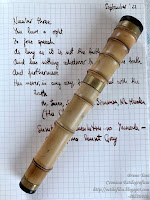Over a year ago, Chinese pen maker Moonman released the model A1, also marketed as Majohn A1. In actual terms, this is a capless pen remarkably similar –being polite-- to the Pilot Capless. So, how do they compare? Or, more precisely, how does the A1 compare to the older original by Pilot?
Size-wise, their dimensions are very close. The Chinese capless is slightly longer and thinner, and is a couple of grams heavier.
 Pilot vs. Moonman. A1 vs. Capless.
Pilot vs. Moonman. A1 vs. Capless.
Externally, the main difference between them is the central ring—almost flat on the Moonman, two toroidal bands on the Pilot. In fact, this flat central ring in the Chinese pen explains its thinner girth.
These are the dimensions of these pens:
|
.Moonman A1.
|
.Pilot Capless. |
| Length closed (mm) |
142 |
141 |
| Length open (mm) |
139 |
137 |
| Max diameter (mm) |
12.9 |
13.2 |
| Weight, dry (g) |
33.7 |
30.0 |
| Ink deposit (ml) |
0.9 (cart)
0.4 (conv) |
0.9 (cart)
0.5 (CON-40) |
 The flat central ring in the Moonman A1.
The flat central ring in the Moonman A1.
Regarding the nibs, the Moonman comes only with a silver-color, stainless steel unit in EF. The Pilot, let us remember, can implement both steel and 18 K gold nibs with up to six different points –from EF to B, plus a stub— and three different finishes —golden, silver, and black— depending on the specific model. However, the most interesting feature is that Moonman made its nib units entirely compatible with those by Pilot: cartridges and converters are interchangeable between brands, and Moonman nibs can be used in Pilot pens, and the other way around.
 The Moonman nib.
The Moonman nib.
And all that at a fraction of the cost of the Pilot Capless. About EUR 30 for the Moonman, and between EUR 80 and EUR 140 for the Pilot. (Japan prices. EUR 140 is approximately the price of the
matte black model (FC-18SR-BM). There are more expensive variations in the Pilot catalog).
Then, the question is whether the Moonman A1 is a copy of the Pilot Capless. I think it is, and the fact that the brand Moonman was clearly written on the nib and on the body does not really change anything. After all, nothing truly original can we see on this Chinese pen.
Now, is Moonman legitimized to manufacture this pen? Moonman is not the first company doing so. In Japan, about 100 years ago,
Nobuo Ito's Swan was copying UK's Swan pens under the protection of Japanese laws and courts. After all, every industrial revolution –save the British- was made copying other's products. And then the idea of fairness depends on
the side of the border we stand on.
The problem, then, is a different one. The current technological environment is very different from that at the heyday of fountain pens. In other words, fountain pens are no longer the essential tool they once were, and their market is not so driven by the necessity as by the craving. Not by the regular user but by the aficionado. And the Moonman A1 does not offer anything the Pilot didn't several years before... save an excellent price.
Is that enough? Regardless of the answer, Pilot –
and others– should pay close attention to whatever might come out of China.
NOTE (Dec 30th): An anonymous commenter pointed out a detail I had overseen--there is a clipless version of the Moonman A1, and that caters the claims of a number of users of the Pilot model. This shows the attention Moonman --and
other Chinese makers-- pay to the Net and what users and aficionados say in there. I reckon this Chinese clipless capless variation does offer something new, as Platinum did with the removable clip on its
Curidas, and it can be an argument for some older users of the Pilot to choose it.
Thanks, anonymous commenter.
Moonman A1 - Montblanc Burgundy Red
Bruno Taut
December 28th, 2022
etiquetas: Moonman, Pilot, capless, mercado
































































